
Members of the community and area churches came together with Wayne State University officials and students at the Wayne State University School of Medicine to celebrate a new outdoor mural commemorating African American progress in the medical field in Detroit.
The Sept. 18 event featured a number of community and WSU speakers giving remarks in the Shiffman Medical Library before cutting a ribbon at the site of the mural to mark its official inauguration.
The mural, the product of a public humanities initiative to connect a multidisciplinary team of physicians, artists, students and activists with the broader community to celebrate the history of diversity in medicine and public health at Wayne State University and in the city, was installed on the 375-foot-long public-facing concrete wall along the sidewalk north of Scott Hall, on the south side of Canfield Street, on June 13.
The collaborative effort between the College of Fine, Performing and Communication Arts and the School of Medicine was conceived and accomplished in collaboration with Detroit community representatives as a monument to African American progress in the medical field in Detroit and within the global community. It was funded by a grant from Michigan Humanities.
WSU fine arts students designed the mural, based on oral histories of community members with deep roots to the location on which the School of Medicine sits. The area is the former site of the Plymouth Congregational Church in Detroit’s historic Black Bottom and Paradise Valley neighborhoods. The mural is intended as a monument to African American progress in the medical field, in Detroit and within the global community.
A number of descendants of the community medical leaders depicted and celebrated in the mural attended the event.
Barbara Hughes-Smith, a granddaughter of Robert Greenidge, M.D., one of the medical leaders commemorated in the mural, said she would bring friends and relatives to the site to view the mural when they visit Detroit.
“It’s so wonderful that they did this,” she said. “Now these men and women can get the attention they deserve.”
The Rev. Nicholas Hood III, pastor and senior minister of the Plymouth United Church of Christ, located near the School of Medicine, noted that only three of the 27 Black churches that existed in Black Bottom remain in service today. “To my knowledge, there is no other marker to Black Bottom in the city of Detroit,” he said. In his opening prayer, he asked that the mural “keep the flame of truth alive.”
 James Womack, M.D., the assistant minister of Health and Wellness at Plymouth United Church of Christ, served as emcee for the event, introducing speakers who explained how the mural project came together.
James Womack, M.D., the assistant minister of Health and Wellness at Plymouth United Church of Christ, served as emcee for the event, introducing speakers who explained how the mural project came together.
Wael Sakr, M.D., dean of the School of Medicine, said he was amazed to watch the collaboration between art students, medical students, faculty and the community unfold. “I’m certain there are many such murals commemorating the lives and work of Detroiters that could go elsewhere throughout the campus.”
Hasan Elahi, dean of the WSU College of Fine, Performing and Communication Arts, called the mural a “shining example” of people coming together, and noted the project rested upon the oral histories students collected from those with deep roots in the community. He thanked painting and drawing Professor Margi Weir; Sheryl Oring, chair of the James Pearson Duffy Department of Art and Art History; and Grace Serra, WSU Art Collection curator, as well as Beena Sood, M.D., associate dean for Professional Development at the School of Medicine, as key catalysts for the project that culminated in the mural.
Oring noted that the two-year project began in the depths of the COVID-19 pandemic with a call from Dr. Sood, who was interested in how the Department of Art and Art History might work with the School of Medicine to incorporate more art into medical education. “This kept us kind of sane at a time it was very difficult to keep going for some us,” Oring said.
Cara Young, the lead mural artist, said the mural represents true collaboration in the city, including students who collected oral histories from the descendants of the city’s Black medical leadership of the time, church congregation members, medical students, administrators who supported the project, and the artists who designed and painted the piece. In particular, she thanked the School of Medicine’s Black Medical Association and Anita Moncrease, M.D., a graduate of the School of Medicine and chronicler of the Black experience at the school; and Basim Dubaybo, M.D., vice dean of Faculty Affairs and Professional Development at the School of Medicine.
“I hope this becomes a beacon of hope for future Wayne State Students who walk alongside it,” Young said.
